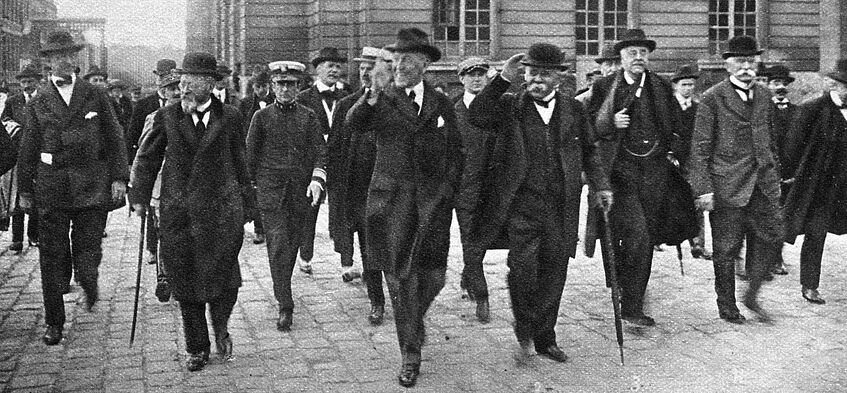
The Treaty of Saint Germain 1919
After the end of the First World War (1914–1918), a total of 21 international treaties and agreements were signed in Paris and its suburbs Versailles, St. Germain-en-Laye, Neuilly-sur-Seine, Trianon and Sèvres between June 1919 and August 1920, placing international law on a completely new footing. At the center of these were the peace treaties with the losing states of the First World War (Germany, Austria-Hungary, Bulgaria, Turkey); the treaty with Austria was signed in St. Germain-en-Laye on September 10, 1919.
The Treaty of St. Germain (VSG) consists of 381 articles as well as several annexes. It not only regulates matters that typically occur in a peace treaty (border demarcation, reparations, arms restrictions, etc.), but also takes into account the fact that the Austro-Hungarian Monarchy had disintegrated, which made it necessary, for example, to regulate the citizenship of former citizens of the imperial and royal monarchy. Monarchy were necessary. Finally, the treaty also contains matters that have no or only a loose connection with the war, such as the founding of the International Labor Organization (ILO), but above all the statutes of the League of Nations, an international organization that is considered the precursor of the UN. Individual parts of the treaty, such as in particular the provisions (essentially still in force today) concerning Austria's borders, have always been of interest to the public as well as to scholars. Other parts, on the other hand, have received insufficient attention so far, despite their partly high practical importance. Even a hundred years after the signing of the treaty, there was no comprehensive, legally stringent analysis of the entire treaty.
The project at hand aimed at correcting this deficit and at examining the entire VSG with legal/legal-historical methods. The subject of the project was therefore not the history of the treaty's origins, which has already been examined in many respects, but rather its legal significance, which is reflected, for example, in the jurisprudence of the Austrian courts, but also in the activities of special arbitration tribunals and other bodies that were established on the basis of or as a result of the VSG. Particular attention should be paid to those provisions that are still in force today and are of practical relevance (such as the constitutional provisions in favor of religious and ethnic minorities). The question of whether a provision is still in force at all had to be answered from both an international law perspective and a domestic perspective.
The project was carried out from 2017 to 2021 under the roof of the Austrian Commission for Legal History of the Austrian Academy of Sciences, in cooperation with the Universities of Graz (Anita Ziegerhofer), Linz (Herbert Kalb) and Vienna (Thomas Olechowski) and supported by the Austrian Science Fund FWF (project P 29774). The focus was on the first comprehensive commentary on the Treaty of Saint Germain, which was compiled by an 18-member team of lawyers, historians and a geodesist. In addition, a number of other publications were produced and presentations were given at conferences; in September 2018, an international conference on "The Treaty of Saint Germain in the International Context of the European Postwar Order" took place at the Austrian Academy of Sciences, the results of which were published in a BRGÖ thematic volume in 2019.
